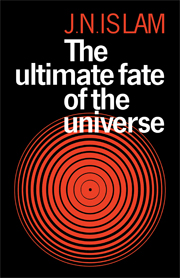Book contents
- Frontmatter
- Contents
- Preface
- Dedication
- Note on some conventions
- 1 Introduction
- 2 Our Galaxy
- 3 The large-scale structure of the universe
- 4 Elementary particles – a preliminary look
- 5 Is the universe open or closed?
- 6 Three ways for a star to die
- 7 Black holes and quasars
- 8 Galactic and supergalactic black holes
- 9 A black hole is not forever
- 10 Slow and subtle changes
- 11 Future of life and civilization
- 12 A collapsing universe
- 13 The steady state theory
- 14 The stability of the proton
- 15 Epilogue
- Glossary
- Selected bibliography
- Index
8 - Galactic and supergalactic black holes
Published online by Cambridge University Press: 06 July 2010
- Frontmatter
- Contents
- Preface
- Dedication
- Note on some conventions
- 1 Introduction
- 2 Our Galaxy
- 3 The large-scale structure of the universe
- 4 Elementary particles – a preliminary look
- 5 Is the universe open or closed?
- 6 Three ways for a star to die
- 7 Black holes and quasars
- 8 Galactic and supergalactic black holes
- 9 A black hole is not forever
- 10 Slow and subtle changes
- 11 Future of life and civilization
- 12 A collapsing universe
- 13 The steady state theory
- 14 The stability of the proton
- 15 Epilogue
- Glossary
- Selected bibliography
- Index
Summary
From the last two chapters it is evident that all stars in a typical galaxy will eventually be reduced to white dwarfs, neutron stars or black holes. There will be formation of new stars from the interstellar gas but eventually most of this gas will be used up in making stars which will eventually die. The remaining gas will be too thinly dispersed and cold to make new stars. The remnants of supernova explosions could also lead to the formation of new stars but finally these remnants would become too rich in heavy elements for the normal process of star formation to take place. Thus given sufficient time, the galaxy will simply consist of cold white dwarfs, neutron stars, black holes and other forms of cold interstellar matter such as planets, asteroids, meteors, rocks, dust, etc. From the energy content of a typical galaxy, it can be shown that this stage will be reached in not much more than a thousand billion (1012) years or so. All galaxies will be losing energy by radiation to intergalactic space. The intergalactic space can be considered as a vast receptacle into which all the energy of the galaxies can be poured without raising its temperature. This is both because the empty space between galaxies increases as the universe expands and because the radiation given off by galaxies gets red shifted and becomes weaker.
- Type
- Chapter
- Information
- The Ultimate Fate of the Universe , pp. 82 - 89Publisher: Cambridge University PressPrint publication year: 1983



